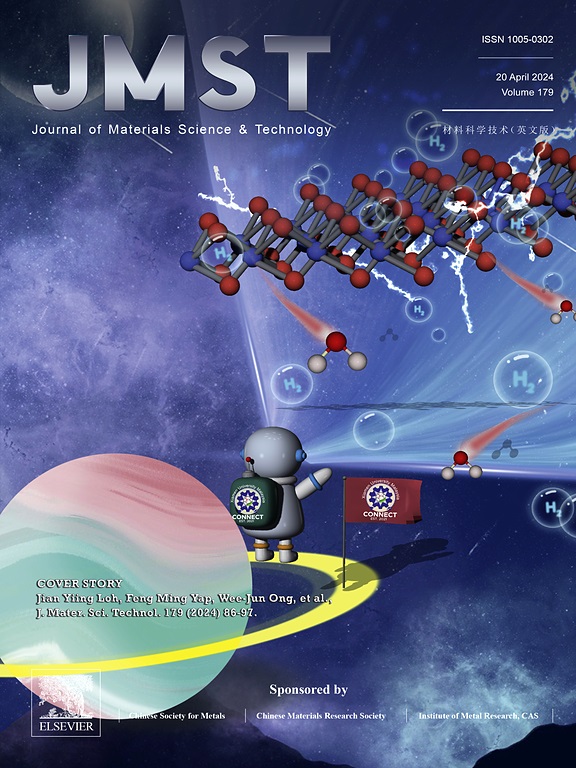仿生肌肉束状核壳纤维束结构增强Cf/Si3N4复合材料韧性
IF 14.3
1区 材料科学
Q1 MATERIALS SCIENCE, MULTIDISCIPLINARY
引用次数: 0
摘要
受生物材料启发对材料的微观结构进行建模,为制造具有更高韧性的复合材料开辟了一条行之有效的途径。本文结合仿生学的概念,利用仿生肌肉束状纤维束结构来提高Cf/Si3N4复合材料的韧性。以Li2O-Al2O3-SiO2 (LAS)为原料,在碳纤维表面原位生长SiC纳米线(SiCnw)。随后,在烧结过程中,用Li-O-Al体系包裹纤维,形成连续的纳米层结构。值得注意的是,被纳米层包裹的碳纤维形成了类似肌肉束的纤维束结构。与单一纤维相比,肌束状结构具有更强的韧性。当受到外力作用时,强韧性使其在断裂过程中不易断裂,从而产生更明显的拉出。肌束状结构利用这种拉出机制吸收大量断裂能量,使断裂韧性提高24.5%,断裂功提高98.4%。这表明通过中间相将纤维连接成纤维束结构可以有效地发挥能量吸收机制,为提高纤维增韧复合材料的力学性能提供了新的思路。本文章由计算机程序翻译,如有差异,请以英文原文为准。

Bio-inspired muscle fascicle-like core–shell fiber bundle structure for enhanced toughness of Cf/Si3N4 composites
Modeling the microstructure of materials inspired by biomaterials opens up a proven route to making composites with higher toughness. Combined with the concept of bionics, this paper utilized a bio-inspired muscle fascicle-like fiber bundle structure to improve the toughness of Cf/Si3N4 composites. Li2O-Al2O3-SiO2 (LAS) was chosen as the raw material to grow SiC nanowires (SiCnw) in situ on the surface of carbon fibers. Subsequently, in the sintering process, the fibers were encapsulated with the Li-O-Al system to form a continuous nanolayer structure. Notably, the carbon fibers wrapped by the nanolayers formed a muscle fascicle-like fiber bundle structure. Compared with single fibers, the muscle fascicle-like structure has stronger toughness. When subjected to external forces, the strong toughness makes it less likely to break during the fracture process, resulting in a more pronounced pull-out. Muscle fascicle-like structures utilize this pull-out mechanism to absorb a large amount of fracture energy, resulting in a 24.5% increase in fracture toughness and a 98.4% improvement in work of fracture. This suggests that connecting the fibers into a fiber bundle structure through the intermediate phase can effectively exert the energy absorption mechanism, which provides a new idea to improve the mechanical properties of fiber-toughened composites.
求助全文
通过发布文献求助,成功后即可免费获取论文全文。
去求助
来源期刊

Journal of Materials Science & Technology
工程技术-材料科学:综合
CiteScore
20.00
自引率
11.00%
发文量
995
审稿时长
13 days
期刊介绍:
Journal of Materials Science & Technology strives to promote global collaboration in the field of materials science and technology. It primarily publishes original research papers, invited review articles, letters, research notes, and summaries of scientific achievements. The journal covers a wide range of materials science and technology topics, including metallic materials, inorganic nonmetallic materials, and composite materials.
 求助内容:
求助内容: 应助结果提醒方式:
应助结果提醒方式:


